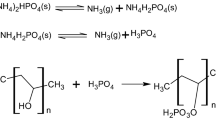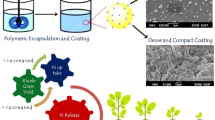Abstract
Polymer coating of water soluble fertilizers to curb excess solubilization of nutrients is well-acknowledged fact. Lack of information on phosphorus (P) release from controlled release nitrogen-phosphorus (NP) formulation and its impact on nutrient use indices has driven us to conduct this experiment. We developed NP formulations by reacting liquid ammonia and orthophosphoric acid in laboratory. Resulting NP formulations were characterized by solubility fractions, microscopy, spectroscopy, and X-ray diffraction. After coating with poly(vinyl alcohol) (PVA) and liquid paraffin (LP) at 2 and 3 w/w% concentration, P release kinetics and temperature sensitivity (Q10) of the formulations were compared with diammonium phosphate (DAP) at 20 and 30 °C temperature in a P-deficient soil for 120 h of incubation. Finally, nutrient use efficiency and relative efficiency indices were determined from a greenhouse experiment in potted soil to assess the effect of polymer-coated formulations and of DAP at two application rates in comparison with a non-P amended control. Laboratory synthesized NP formulations were alkaline in reaction, definite cubical to hexagonal crystalline structure with smooth surface generating peaks related to P and N in fingerprinting region of Fourier transform infrared spectroscopy. Polymer coating of NP formulations delayed the P release compared with DAP, while LP-coated formulations showing slower P release than PVA-based coatings. Despite LP-coated formulations showed greater temperature sensitivity (Q10), the PVA-based formulation significantly increased yield and biomass accumulation of wheat, with concomitant increase in crop P uptake and P use efficiency. Both LP and PVA-coated formulations showed a significant residual P accumulation in post-harvest soils. The findings underline the potential of polymer coating technology for enhancing P use efficiencies, thereby reducing environmental P footprints.

Graphical Abstract









Similar content being viewed by others
References
Abdala DB, Northrup PA, Arai T, Sparks DL (2015) Surface loading effects on orthophosphate surface complexation at the goethite/water interface as examined by extended X-ray absorption fine structure (EXAFS) spectroscopy. J Colloid Interf Sci 437:297–303
Adams C, Frantz J, Bugbee B (2013) Macro- and micronutrient-release characteristics of three polymer-coated fertilizers: theory and measurements. J Plant Nutr Soil Sci 176:76–88
Ali I, Mustafa A, Yaseen M, Imran M (2017) Polymer coated DAP helps in enhancing growth, yield and phosphorus use efficiency of wheat (Triticum aestivum L.). J Plant Nutr 40:2587–2594
Barahuie F, Dorniani D, Saifullah B, Gothai S, Hussein MZ, Pandurangan AK, Arulselvan P, Norhaizan P (2017) Sustained release of anticancer agent phytic acid from its chitosan-coated magnetic nanoparticles for drug-delivery system. Int J Nanomedicine 12:2361–2372
Biswas DR, Narayanasamy G (2002) Mobilization of phosphorus from rock phosphate through composting using crop residue. Fert News 47:53–56
Bouyoucos GJ (1962) Hydrometer method improved for making particle size analysis of soils. Agron J 54:464–465
Cordell D, Drangert JO, White S (2009) The story of phosphorus: global food security and food for thought. Glob Environ Chang 19:292–305
Crusciol CAC, Almeida DS, Alves CJ, Soratto RP, Krebsky EO, Spolidorio ES (2019) Can micronized sulfur in urea reduce ammoniacal nitrogen volatilization and improve maize grain yield? J Soil Sci Plant Nutr 19:701–711
da Cruz DF, Bortoletto-Santos R, Guimaraes GGF, Polito LW, Ribeiro C (2017) Role of polymeric coating on the phosphate availability as a fertilizer: insight from phosphate release by castor polyurethane coatings. J Agric Food Chem 65:5890–5895
Du C, Zhou J, Shaviv A (2006) Release characteristics of nutrients from polymer-coated compound controlled release fertilizers. J Polym Environ 14:223–230
FAO (2014) IUSS working group WRB. World reference base for soil resources 2014. International soil classification system for naming soils and creating legends for soil maps. World Soil Resources Reports No. 106. FAO, Rome
Gargouri M, Chtara C, Charrock P, Nzihou A, El Feki H (2011) Synthesis and physicochemical characterization of pure diammonium phosphate from industrial fertilizer. Ind Eng Chem Res 50:6580–6584
Giroto SA, Guimarães GGF, Foschini M, Ribeiro C (2017) Role of slow-release nanocomposite fertilizers on nitrogen and phosphate availability in soil. Sci Res 7:46032. https://doi.org/10.1038/srep46032
Guntinas ME, Leiros MC, Trasar-Cepeda C, Gil-Sotres F (2012) Effects of moisture and temperature on net soil nitrogen mineralization: a laboratory study. Euro J Soil Biol 48:73–80
Han X, Chena S, Hub X (2009) Controlled-release fertilizer encapsulated by starch/polyvinyl alcohol coating. Desalination 240:21–26
Hanway JJ, Heidel H (1952) Soil analysis methods as used in Iowa State College, Soil Testing Laboratory. Iowa Agric 54:1–31
Irfan SA, Razali R, KuShaari K, Mansor N, Azeem B, Versypt ANF (2018) A review of mathematical modeling and simulation of controlled-release fertilizers. J Cont Rel 271:45–54
Jackson ML (1973) Soil chemical analysis. Prentice Hall of India Pvt. Ltd., New Delhi
Ji X, Kong N, Wang J, Li W, Xiao Y, Gan ST, Zhang Y, Li Y, Song X, Xiong Q, Shi S, Li Z, Tao W, Zhang H, Mei L, Shi J (2018) A novel top-down synthesis of ultrathin 2d boron nanosheets for multimodal imaging-guided cancer therapy. Adv Mater 30(36):1803031. https://doi.org/10.1002/adma.201803031
Keeney DR, Nelson DW (1982) Nitrogen mineral forms. In: Page AL, Miller RH, Keeney DR (eds) Methods of soil analysis. Agronomy monograph 9, part 2, second edn. American Society of Agronomy, Madison, pp 643–698
Lindsay WL, Norvell WA (1978) Development of a DTPA soil test for zinc, iron, manganese and copper. Soil Sci Soc Am J 42:421–428
Lubkowski K, Smorowska A, Grzmil B, Kozłowska A (2015) Controlled-release fertilizer prepared using a biodegradable aliphatic copolyester of poly(butylene succinate) and dimerized fatty acid. J Agri Food Che 63:2597–2605
Luo M, Fan T, Zhou Y, Zhang H, Mei L (2019) 2D Black phosphorus–based biomedical applications. Adv Func Mater. https://doi.org/10.1002/adfm.201808306
Ma Z, Jia X, Zhang G, Hu J, Zhang X, Liu Z, Wang H, Zhou F (2013) pH-responsive controlled-release fertilizer with water retention via atom transfer radical polymerization of acrylic acid on mussel- inspired initiator. J Agric Food Chem 61:5474–5482
Mahendran PP, Narayanasamy G, Biswas DR (2005) Effect of levels and methods of acidulation on the properties of partially acidulated phosphate rocks and their agronomic potential in an udic Haplustalf. J Indian Soc Soil Sci 53:369–375
Mengel K, Kirkby EA (1987) Principles of plant nutrition. International Potash Institute, Worblaufen-Bern
Messa LL, Souza CF, Faez R (2019) Spray-dried potassium nitrate-containing chitosan/montmorillonite microparticles as potential enhanced efficiency fertilizer. Polym Test 81:106196. https://doi.org/10.1016/j.polymertesting.2019.106196
Moharana PC, Biswas DR (2016) Assessment of maturity indices of rock phosphate enriched composts using variable crop residues. Bioresour Technol 222:1–13
Naz MY, Sulaiman SA (2017) Attributes of natural and synthetic materials pertaining to slow-release urea coating industry. Rev Chem Eng 33:293–308
Noppakundilograt S, Pheatcharat N, Kiatkamjornwong S (2015) Multilayer-coated NPK compound fertilizer hydrogel with controlled nutrient release and water absorbency. App Polym 41249:1–11
Olsen SR, Cole CV, Watanabe FS, Dean LA (1954) Estimation of available phosphorus in soils by extraction with sodium bicarbonate. United States Department of Agriculture Circular No. 939
Pauly DG, Nyborg M, Malhi SS (2002) Controlled-release P fertilizer concept evaluation using growth and P uptake of barley from three soils in a greenhouse. Can J Soil Sci 82:201–210
Puguan JMC, Kim HS, Lee KJ, Kim H (2014) Low internal concentration polarization in forward osmosis membranes with hydrophilic crosslinked PVA nanofibers as porous support layer. Desalination 336:24–31
Qiu M, Wang D, Liang W, Liu L, Zhang Y, Chen X, Sang DK, Xing C, Li Z, Dong B, Xing F, Fan D, Bao S, Zhang H, Cao Y (2017) Novel concept of the smart NIR-light–controlled drug release of black phosphorus nanostructure for cancer therapy. Proc National Aca Sci 115:501–506
Qiu M, Singh A, Wang D, Qu J, Swihart M, Zhang H, Prasad PN (2019) Biocompatible and biodegradable inorganic nanostructures for nanomedicine: silicon and black phosphorus. Nano Today 25:135–155
Ritger PL, Peppas NA (1987a) A simple equation for description of solute release I. Fickian and non-fickian release from non-swellable devices in the form of slabs, spheres, cylinders or discs. J Cont Rel 5:23–36
Ritger PL, Peppas NA (1987b) A simple equation for description of solute release II. Fickian and anomalous release from swellable devices. J Cont Rel 5:37–42
Rocha MA, Petersen PAD, Teixeira-Neto E, Petrilli HM, Leroux F, Taviot-Gueho C, Constantino VRL (2016) Layered double hydroxide and sulindac coiled and scrolled nanoassemblies for storage and drug release. RSC Adv 6:16419–16436
Roy T, Biswas DR, Datta SC, Dwivedi BS, Lata N, Bandyopadhyay KK, Sarkar A, Agarwal BK, Shahi DK (2015) Solubilization of Purulia rock phosphate through organic acid loaded nanoclay polymer composite and phosphate solubilizing bacteria and its effectiveness as P-fertilizer to wheat. J Indian Soc Soil Sci 63:327–338
Roy T, Biswas DR, Datta SC, Sarkar A, Biswas SS (2018a) Citric acid loaded nano clay polymer composite for solubilization of Indian rock phosphates: a step towards sustainable and phosphorus secure future. Arch Agro Soil Sci 64:1564–1581
Roy T, Biswas DR, Datta SC, Sarkar A (2018b) Phosphorus release from rock phosphate as influenced by organic acid loaded nanoclay polymer composites in an Alfisol. Proc Natl Acad Sci India: Sect B: Biol Sci 88:121–132
Sarkar A, Biswas DR, Datta SC, Manjaiah KM, Roy T (2017) Release of phosphorus from laboratory made coated phosphatic fertilizers in soil under different temperature and moisture regimes. Proc Natl Acad Sci India: Sect B: Biol Sci 87:1299–1308
Sarkar A, Biswas DR, Datta SC, Roy T, Moharana PC, Biswas SS, Ghosh A (2018) Polymer coated novel controlled release rock phosphate formulations for improving phosphorus use efficiency by wheat in an Inceptisol. Soil Till Res 180:48–62
SAS Institute, Inc (2004) SAS/STAT® 9.1 User’s guide. SAS Institute, Inc. Publisher, Cary
Scholz RW, Roy AH, Hellums DT (2014) Sustainable phosphorus management: a transdisciplinary challenge. In: Scholz RW, Roy AH, Brand FS, Hellumps DT, Ulrich AE (eds) Sustainable phosphorus management a global transdisciplinary roadmap. Springer, Dordrecht, pp 1–128
Sempeho SI, Kim HT, Mubofu E, Hilonga A (2014) Meticulous overview on the controlled release fertilizers. Adv Chem 2014:363071. https://doi.org/10.1155/2014/36307
Shaviv A (2001) Advances in controlled release fertilizers. Adv Agron 71:1–49
Siepmann J, Peppas NA (2012) Modeling of drug release from delivery systems based on hydroxypropyl methylcellulose (HPMC). Adv Drug Deliv Rev 64:163–174
Soil Survey Staff (2014) Keys to soil taxonomy, 12th edn. United States Department of Agriculture, Natural Resources Conservation Service 360p
Tao W, Kong N, Ji X, Zhang Y, Sharma A, Ouyang J, Qi B, Wang J, Xie N, Kang C, Zhang H, Farokhzad OC, Kim JS (2019) Emerging two-dimensional monoelemental materials (Xenes) for biomedical applications. Chem Soc Rev 48:2891
Teixeira RS, da Silva IR, de Sousa RN, Mattiello EM, Soares EMB (2016) Organic acid coated-slow-release phosphorus fertilizers improve P availability and maize growth in a tropical soil. J Soil Sci Plant Nutr 16:1097–1112
Walkley A, Black IA (1934) An examination of the Degtjareff method for determining soil organic matter, and a proposed modification of the chromic acid titration method. Soil Sci 37:29–38
Wu L, Liu M, Liang R (2008) Preparation and properties of a double-coated slow release NPK compound fertilizer with superabsorbent and water-retention. Bioresour Technol 99:547–554
Yaseen M, Aziz MZ, Manzoor A, Naveed M, Hamid Y, Noor S, Khalid MA (2017) Promoting growth, yield, and phosphorus-use efficiency of crops in maize–wheat cropping system by using polymer-coated diammonium phosphate. Commun Soil Sci Plant Anal 48:646–655
Zablon M, Azimova M (2016) Wax-based fertilizer coatings with polyethylene- or polypropylene-based polymers. WO 2016/191098 Al
Acknowledgments
The authors would like to thank the Head, Division of Soil Science and Agricultural Chemistry, ICAR-IARI, New Delhi, for providing instrumental and laboratory facilities for conducting the research work.
Funding
The first author thanks the Indian Council of Agricultural Research (ICAR), New Delhi, India, for providing financial support as Junior Research Fellowship to carry out the post graduate research program at ICAR-Indian Agricultural Research Institute (IARI).
Author information
Authors and Affiliations
Corresponding author
Ethics declarations
Conflict of Interest
The authors declare that they have no conflict of interest.
Additional information
Publisher’s Note
Springer Nature remains neutral with regard to jurisdictional claims in published maps and institutional affiliations.
Electronic Supplementary Material
ESM 1
(DOCX 219 kb)
Rights and permissions
About this article
Cite this article
Sarkar, A., Biswas, D.R., Datta, S.C. et al. Synthesis of Poly(vinyl alcohol) and Liquid Paraffin-Based Controlled Release Nitrogen-Phosphorus Formulations for Improving Phosphorus Use Efficiency in Wheat. J Soil Sci Plant Nutr 20, 1770–1784 (2020). https://doi.org/10.1007/s42729-020-00249-3
Received:
Accepted:
Published:
Issue Date:
DOI: https://doi.org/10.1007/s42729-020-00249-3




